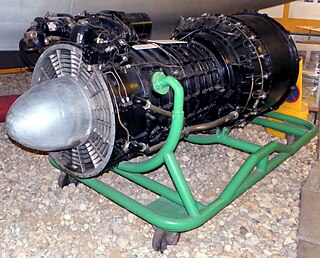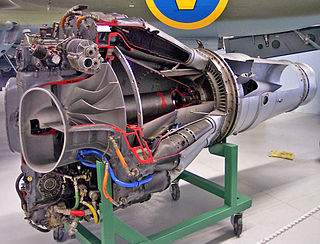Related Research Articles

The BMW 003 is an early axial turbojet engine produced by BMW AG in Germany during World War II. The 003 and the Junkers Jumo 004 were the only German turbojet engines to reach production during World War II.

The Metropolitan-Vickers F.2 is an early turbojet engine and the first British design to be based on an axial-flow compressor. It was an extremely advanced design for the era, using a nine-stage axial compressor, annular combustor, and a two-stage turbine.

The de Havilland Goblin, originally designated as the Halford H-1, is an early turbojet engine designed by Frank Halford and built by de Havilland. The Goblin was the second British jet engine to fly, after Whittle's Power Jets W.1, and the first to pass a type test and receive a type certificate issued for an aircraft propulsion turbine.

The General Electric J85 is a small single-shaft turbojet engine. Military versions produce up to 2,950 lbf (13.1 kN) of thrust dry; afterburning variants can reach up to 5,000 lbf (22 kN). The engine, depending upon additional equipment and specific model, weighs from 300 to 500 pounds. It is one of GE's most successful and longest in service military jet engines, with the civilian versions having logged over 16.5 million hours of operation. The United States Air Force plans to continue using the J85 in aircraft through 2040. Civilian models, known as the CJ610, are similar but supplied without an afterburner and are identical to non-afterburning J85 variants, while the CF700 adds a rear-mounted fan for improved fuel economy.

The Lyulka AL-7 was a turbojet designed by Arkhip Mikhailovich Lyulka and produced by his Lyulka design bureau. The engine was produced between 1954 and 1970.

The Heinkel HeS 3 was the world's first operational jet engine to power an aircraft. Designed by Hans von Ohain while working at Heinkel, the engine first flew as the primary power of the Heinkel He 178, piloted by Erich Warsitz on 27 August 1939. Although successful, the engine had too little thrust to be really useful, and work started on the more powerful Heinkel HeS 8 as their first production design.

The Lotarev DV-2 is a two-spool turbofan engine manufactured in Považská Bystrica, Slovakia by Považské Strojárne Letecké Motory (PSLM) and designed in partnership with Ivchenko Lotarev Design Bureau.
The Avro Canada TR.4 Chinook was Canada's first turbojet engine, designed by Turbo Research and manufactured by A.V. Roe Canada Ltd. Named for the warm Chinook wind that blows in the Rocky Mountains, only three Chinooks were built and none were used operationally. After being scaled up from 2,600 lbf (12 kN) to 6,500 lbf (29 kN), it would become the Orenda.

The Avro Canada TR5 Orenda was the first production jet engine from Avro Canada's Gas Turbine Division. Similar to other early jet engines in design, like the Rolls-Royce Avon or General Electric J47.

The General Electric YJ93 turbojet engine was designed as the powerplant for both the North American XB-70 Valkyrie bomber and the North American XF-108 Rapier interceptor. The YJ93 was a single-shaft axial-flow turbojet with a variable-stator compressor and a fully variable convergent/divergent exhaust nozzle. The maximum sea-level thrust was 28,800 lbf (128 kN).

The Westinghouse J46 is an afterburning turbojet engine developed by the Westinghouse Aviation Gas Turbine Division for the United States Navy in the 1950s. It was primarily employed in powering the Convair F2Y Sea Dart and Vought F7U Cutlass. The engine also powered the land speed-record car known as the Wingfoot Express, designed by Walt Arfons and Tom Green It was intended to power the F3D-3, an improved, swept-wing variant of the Douglas F3D Skyknight, although this airframe was never built.

The General Electric T31 was the first turboprop engine designed and built in the United States.

The General Electric J73 turbojet was developed by General Electric from the earlier J47 engine. Its original USAF designation was J47-21, but with innovative features including variable inlet guide vanes, double-shell combustor case, and 50% greater airflow was redesignated J73. Its only operational use was in the North American F-86H.

The Power Jets W.1 was a British turbojet engine designed by Frank Whittle and Power Jets. The W.1 was built under contract by British Thomson-Houston (BTH) in the early 1940s. It is notable for being the first British jet engine to fly, as the "Whittle Supercharger Type W1", powering the Gloster E.28/39 on its maiden flight at RAF Cranwell on 15 May 1941. The W.1 was superseded by the Power Jets W.2.

The PZL Rzeszów SO-1 and PZL Rzeszów SO-3 are Polish turbojet engines designed by the Instytut Lotnictwa and manufactured by WSK PZL Rzeszów, to power the PZL TS-11 Iskra jet trainer. Thirty SO-1s were built, this being superseded by the improved SO-3, of which a further 580 were built. The engine has a seven-stage compressor, annular combustion chambers, and a single-stage turbine.
The Flader J55, also known as the 124 within the company, was a small turbojet engine notable for its use of a supersonic axial-flow compressor. Development started at Fredric Flader Inc. in 1947, with the first examples being delivered in 1949. However, these delivered far lower power than predicted. Improved models followed in early 1952 that met the performance requirements, but demonstrated very poor reliability. When small engines from other companies became available, the J55 project was cancelled in 1952.
The West Engineering XJ38 was a small turbojet engine created by modifying World War II-surplus aircraft engine turbosuperchargers. Intended to be a cheap method of producing jet engines for target drones for the United States Navy, the latter lost interest in the project, which was soon discontinued because of lack of funding.
The Packard XJ49 was the first U.S. designed turbofan aircraft engine, and was developed by the Packard Motor Co. in the 1940s.
The Daimler-Benz DB 007 was an early German jet engine design stemming from design work carried out by Karl Leist from 1939. This was a complex design featuring contra-rotating stages and a bypass fan, making it one of the earliest turbofan designs to be produced. The end result of the design work was built as the DB 007 and began testing on a test-bed on 27 May 1943. Due to the expected low performance, complexity and the good results achieved by much simpler designs, work was halted on the DB 007 in May 1944 by order of the RLM.
The Progress AI-22 is a turbofan engine, developed by ZMKB Progress, Motor Sich JSC, KMPO and KAPO.
References
- Notes
- 1 2 3 4 5 6 Neal, Bob. "STATISTICS OF ALL THE AERO ENGINES OF PACKARD" (PDF). .enginehistory.org. Archived from the original (PDF) on 25 March 2015. Retrieved 24 January 2013.
- Bibliography
- Kay, Anthony L. (2007). Turbojet History and Development 1930-1960 Volume 2:USSR, USA, Japan, France, Canada, Sweden, Switzerland, Italy and Hungary (1st ed.). Ramsbury: The Crowood Press. ISBN 978-1861269393.